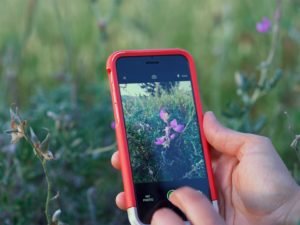iNaturalist: A New Way to Engage with Nature
Imagine the first time you went bird-watching with binoculars. Perhaps you can recall the first time that you looked at pond water under the microscope. Maybe you have recently seen a child look at some bugs with a magnifying glass. These tools amplify our enjoyment of nature. Without them, we can still enjoy nature, of course, but by utilizing them, we can see and appreciate so much more.
Over a decade ago, I was introduced to the citizen science app iNaturalist at a workshop led by Texas Parks and Wildlife Department urban biologists. I must admit, I played with it for a few days but became quite bored. As with most apps on my phone, I deleted it in almost the exact time it took to download it! A few months later, I was reminded about iNaturalist and went to the website and looked at my data. The “dots” that I submitted were joined with many other dots and an interesting picture of distribution was created. I re-downloaded the app, used my camera, and continued to make some data points of observations. After a little more time, I realized that iNaturalist isn’t just an app; it is a community, a database, and most importantly, a tool. It is a tool that helps me see things that I didn’t notice before. With it, I’ve gained so much more appreciation for all of the organisms that I share the planet with. I’ve learned the names of my natural neighbors!
iNaturalist started in 2008 as a masters project at Berkeley and now has over 7 million observations of 125,000 species from 175,000 global participants. With this tool, you can photograph or record an organism’s presence in space and time, and that digital voucher is uploaded to the iNaturalist network to be identified, verified, and appreciated by naturalists and scientists around the world. If you don’t know what the organism is, the community provides guidance with comments and identifications. Finding the name of the species is like learning a password. So much more knowledge is gained when you find out the identity of something. On the iNaturalist website, you can see what others have seen around you, print out local field guides, check out projects, and so much more.
Now that I am an urban biologist with Texas Parks and Wildlife, I actively use the data generated on iNaturalist by citizen scientists. I use these photographs and information to show policy makers and public land managers that not only does biodiversity exist in the urban area, but also that there is an active constituency of folks that seek out these areas! This has substantial management and policy implications, and I’ve been fortunate to see action generated by this citizen science movement.
As a matter of fact, urban areas around the world are “competing” to see which area has the most diversity and greatest amount of citizen scientists that want to document it! The city nature challenge will occur on April 28 – May 1. If you’re able to, please help us document nature in urban areas across the state! More information at www.citynaturechallenge.com.
I thoroughly enjoy using iNaturalist. I’ve met such an amazing group of naturalists online and in person. I’ve been able to learn the names of so many plants and animals that I share the planet with. I use the digital and filterable field guide and calendar as my field notes. It truly is a tool that helps me engage with and appreciate nature.
Over 400 cities across the world will participate in this year's City Nature Challenge, the free and fun wildlife-observation contest.
Join us! YOUR unique observations will help biologists better understand the wildlife of Texas – plus, your community needs your participation to win. It's easy:
Find wildlife (animal, plant or fungus)
Take a picture or record a sound anytime from 4/28 to 5/1
Share using iNaturalist online or the iNaturalist app
If you don't see your city listed, join the global community. It's a great excuse for spending your day (or night) with wildlife! Check the FAQ page for more info.
If you have any questions, feel free to reach out:
Sam Kieschnick
Urban Wildlife Biologist, Texas Parks and Wildlife Department
sam.kieschnick@tpwd.texas.gov
or message me at sambiology on iNaturalist!
Sam Kieschnick is an urban wildlife biologist with Texas Parks and Wildlife Department serving the Dallas/Fort Worth metroplex; he was recently recognized as one of the top 10 iNaturalist users in the world. He previously worked as a nature educator with the City of Mansfield at Oliver Nature Park, as a naturalist at the Fort Worth Nature Center and Refuge, as a science interpreter with the Fort Worth Museum of Science and History, as a botanist with BRIT, and as an instructor at Weatherford College. He has a master’s degree from Tarleton State University studying the genetics of pocket gophers. As an urban wildlife biologist, Sam’s focus will be on three a’s: awareness, appreciation, and action.





